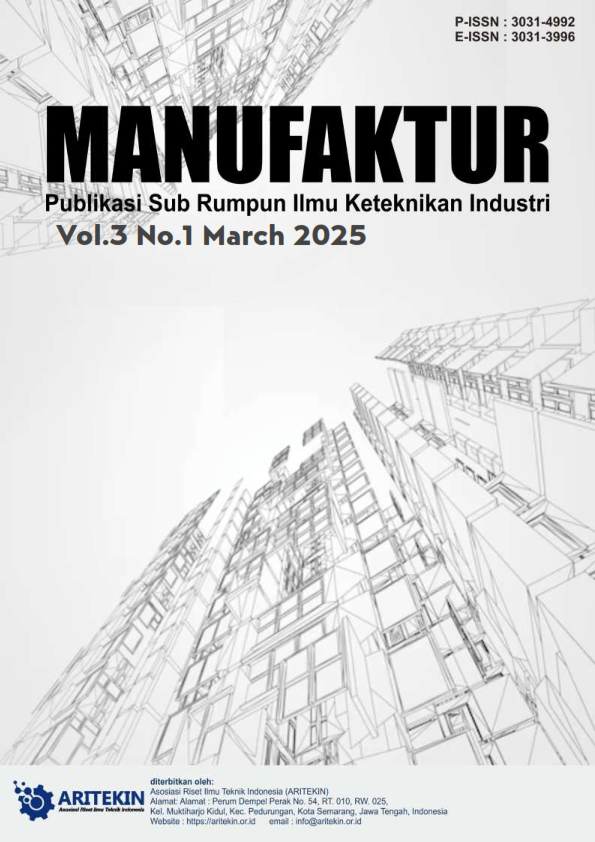Optimalisasi Formulasi Shampo Herbal Ramah Lingkungan dengan Bahan Alami Daun Randu dan Biji Pepaya
DOI:
https://doi.org/10.61132/manufaktur.v3i1.771Keywords:
Herbal Shampoo, Ceiba Pentandra, Carica Papaya Seeds, Natural Ingredients, Mathematical Model, Influence Diagram, Eco-FriendlyAbstract
This study aims to develop a natural-based herbal shampoo using Ceiba pentandra (L.) Gaertn leaves and Carica papaya L. seeds as a safer and eco-friendly alternative to synthetic shampoos, which often contain harmful chemicals. Ceiba pentandra leaves contain active compounds such as flavonoids, alkaloids, and saponins with antibacterial properties, while Carica papaya seeds contain glucoside circirindan, which is beneficial for treating gray hair. The research method involves the use of influence diagrams and mathematical models to determine the most effective ingredient formulation. The experimental results showed that the best composition consists of 60 grams of Ceiba pentandra leaves, 30 grams of Carica papaya seeds, 5 grams of texavon, 10 grams of NaCl, and 350 ml of distilled water. The resulting herbal shampoo product is not only effective and economical but also environmentally friendly.
References
Badan Standarisasi Nasional. (2018). SNI 16-4371-1996: Sampo Cair. Jakarta: BSN.
Berbasis Herbal. Jurnal Matematika Terapan, 10(3), 78-90.
Budiman, A., & Sari, R. (2020). Pemanfaatan Bahan Alami dalam Produk Perawatan
Destriyana, 2012. 6 Masalah rambut paling popular dan solusinya. http//:Merdeka.com, diakses pada hari rabu 18 oktober 2017.
Hanum, T. Ismanelly, and Siti Indah Lestari. "Formulasi Tablet Hisap Ekstak Etanol Daun Randu (Ceiba Pentandra L. Gaertn) Menggunakan Carboxy Methyl Cellulose (CMC) Sebagai Bahan Pengikat Dengan Metode Granulasi Basah." Talenta Conference Series: Tropical Medicine (TM). Vol. 1. No. 3. 2018.
Harahap, R., & Suryani, T. (2021). Analisis Kandungan Kimia Daun Randu (Ceiba pentandra
Kementerian Kesehatan RI. (2019). Farmakope Herbal Indonesia Edisi III. Jakarta: Kemenkes
Kreis, W., & Mueller-Uri, F. (2010). Bioactive Plant Compounds: Their Role in Health and Disease. Journal of Natural Products, 12(4), 215–230.
Kumar, P., & Patel, M. (2019). Phytochemical and Pharmacological Aspects of Carica papaya: A Review. International Journal of Herbal Medicine, 7(2), 45-52.
L.) dan Potensinya sebagai Bahan Herbal. Jurnal Biologi Tropis, 8(1), 45-55.
Milind Parle and Gurditta. 2011. Basketful Benefits of Papaya. International Research Journal of Pharmacy 2(7): 6-12.
Nugroho, A., & Widodo, H. (2022). Pemodelan Matematis dalam Formulasi Produk Kosmetik
Rahmadani, F., & Prasetyo, B. (2021). Analisis Kandungan Bioaktif dalam Produk Shampo dan Pengaruhnya terhadap Kesehatan Rambut. Journal of Cosmetic Science, 12(3), 102–110.
Rahmawati, A., & Yulianto, R. (2020). Potensi Biji Pepaya sebagai Bahan Alami dalam Perawatan Rambut. Jurnal Ilmu Kesehatan, 15(1), 78–85.
Rambut. Jurnal Teknologi Kosmetik, 5(2), 112-120.
RI.
Sarjoko,Subandi 2016 Pelaksanaa pengentasan kelaparan serta komsumsi & produk berkelanjutan dalam tujuan pembangunan berkelanjutan(SDGs) di Indonesia diakses pada 18 oktober 2017
Setiawan, B., Utami, R., & Pratiwi, D. (2018). Analisis Kandungan Bioaktif pada Daun Randu untuk Perawatan Rambut. Jurnal Bioteknologi Tropis, 7(3), 112–120.
Downloads
Published
How to Cite
Issue
Section
License
Copyright (c) 2025 Manufaktur: Publikasi Sub Rumpun Ilmu Keteknikan Industri

This work is licensed under a Creative Commons Attribution-ShareAlike 4.0 International License.






